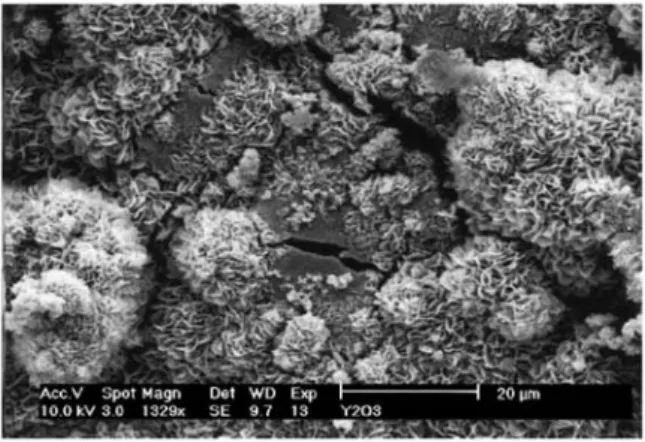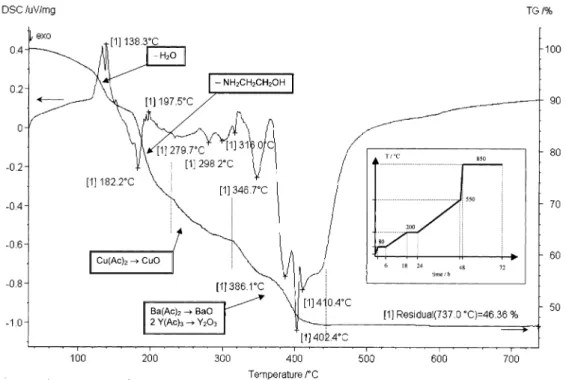Published in:Physica C (2002), vol.372, Part 2, pp.715-718 Status: Postprint (Author’s version)
YBa2Cu3O7 tapes prepared by sol-gel deposition techniques: microstructure
and structural characterizations
D. Marguiller a, R. Cloots a, A. Rulmont a, J.F. Fagnard b, Ph. Vanderbemden b, M. Ausloos c a SUPRAS, LCIS, Chemistry Institute B6, University of Liège, Sart-Tilman, B-4000 Liège, Belgium
b
SUPRAS, Montefiore Electricity Institute B28, University of Liège, Sart-Tilman, B-4000 Liège, Belgium
c SUPRAS, Physics Institute B5, University of Liège, Sart-Tilman, B-4000 Liège, Belgium
Abstract
We report on the preparation conditions of YBa2Cu3O7 polycrystalline superconducting tapes by a sol-gel deposition technique. We present some discussion on the compatibility between the nature of the substrate, the use of a buffer layer, and the conditions used to prepare appropriate superconducting YBa2Cu3O7 materials. We report also on the micro structural characterizations performed in order to evaluate the crystallites size, degree of orientation and connectivity.
Keywords: Superconductivity; Coated conductor; Sol-gel
1. Introduction
The preparation of YBa2Cu3O7 coated conductors has attracted much attention in recent years but in order to compete with other high-Tc superconductors like BSCCO tapes manufactured as long-length conductors, it is necessary to develop low cost manufacturing processes specifically devoted to YBa2Cu3O7 [1]. YBa2Cu3O7 coated conductors prepared by conventional thin film vacuum deposition processes like IBAD [2] do not satisfy price criteria. Moreover, the preparation of YBa2Cu3O7 coated conductors implies to take into account the weak-link nature of poly-crystalline materials. In order to reduce the contribution of weak-weak-links to the physical properties, the approach called RABiTS developed at Oak Ridge [3] consists in combining a biaxially textured substrate, such as nickel, with a thin epitaxial buffer layer. The superconducting layer was deposited by a 'metal-organic' deposition technique. A particular approach to the RABiTS process using sol-gel precursors of the YBa2Cu3O7 phase has been developed at SUPRAS (Liège). The substrate consists of a highly resistant non-corrosive metallic alloy hereafter called DM123. In order to stabilize the substrate against corrosion during the thermal treatment of the superconducting phase, yttrium oxide has been deposited on top of the substrate by an electrochemical process. A good adherence between the substrate and the yttrium oxide buffer layer is a necessary ingredient in order to produce high quality superconducting tapes. Chemical interaction between the substrate and the buffer layer is expected through the formation of a ternary oxide compound at the interface (a few nanometers thick), isolating the substrate from a reaction with the YBa2Cu3O7 superconducting phase. Yttrium oxide has been selected on the basis of its chemical compatibility both towards the substrate and the YBa2Cu3O7 superconducting phase [4].
We report here on the use of an electrochemical process and a subsequent heat treatment in order to induce a good adherence between the buffer layer and the substrate. We report also on the dip-coating process of a YBa2Cu3O7 superconducting film made by a sol-gel reaction, onto the yttrium oxide cap layer. Micro structural investigations show a strong dependence on the growth process of the nature of the substrate layer.
2. Results, techniques and discussion 2.1. Substrate buffer layer
Deposits of yttrium hydroxide were successfully obtained by an electrochemical process from aqueous solutions of yttrium nitrate in potentio-static mode on chemically cleaned metallic substrates at a fixed potential of -1 V with respect to the saturated Calomel electrode as a standard. Yttrium hydroxide can be converted into yttrium oxide by a subsequent heat treatment. It has been recently shown [5] that yttrium hydroxide deposits showed generally low adhesion to metallic substrates. In contrast, deposits obtained from mixed yttrium nitrate and poly(diallyldimethylammo-nium chloride), the so-called PDDA polymer (see Fig. 1), containing solutions adhere to the substrate. PDDA has thus been added to the initial solution until a concentration of 2g/l was
Published in:Physica C (2002), vol.372, Part 2, pp.715-718 Status: Postprint (Author’s version)
reached. Morphologies of the deposits were studied using a Philips environmental scanning electron microscope, and are presented in Fig. 2. Our deposits obtained in the presence of PDDA are indeed uniform and adherent with respect to the substrate.
Notice also that Morrell et al. have reported [6] that yttrium or rare-earth oxide films can be deposited by an alkoxide sol-gel process using spin-coating onto biaxially textured nickel substrates.
Fig. 1: Schematic structure representation of PDDA.
Fig. 2: Scanning electron micrograph of the DM123 metallic substrate covered by an electrochemically
deposited yttrium oxide buffer layer.
2.2. Superconductor
Thick YBa2Cu3O7 films were prepared on metallic substrates (covered or not by yttrium oxide buffer layer) by a dip-coating process starting from Y-, Ba-, and Cu-acetates, in acetic acid solution. Ammonia was used in order to adjust the pH to 3.6, and the solution was maintained at 80 °C for 24 h until a viscous liquid was obtained. A transparent blue gel is obtained by evaporating most of the solvent, and was then deposited by a dip-coating process onto a selected DM123 metallic substrate in the presence or not of a yttrium oxide buffer layer. The composite was progressively heated up to 850 °C. Its decomposition follows a three step process (see inset of Fig. 3) as deduced from the thermogravimetric analysis carried out in air between room temperature and 850°C at a heating rate of 10 °C min-1, using a thermoanalyzer Netzsch (see Fig. 3).
Weight losses during heating are reported in Fig. 3 and revealed the evaporation of the rest of the solvents (water and ammonia) first, followed by the successive decompositions of the acetates, from 200 to 450 °C. The film consists then of BaO, CuO and Y2O3, converted next into the YBa2Cu3O7 phase by a reaction-growth process conducted at 850 °C.
After the calcining step at 850 °C, the deposits were scraped from the metallic substrate for X-ray diffraction analysis on a Siemens D5000 powder X-ray diffractometer. X-ray analysis shows that the films are phase-pure YBa2Cu3O7.
Published in:Physica C (2002), vol.372, Part 2, pp.715-718 Status: Postprint (Author’s version)
Microstructure analysis was then performed using a Philips environmental scanning microscope. The micro structures of YBa2Cu3O7 films deposited onto the metallic substrate covered or not by the yttrium oxide buffer layer are reported in Fig. 4(a) and (b) respectively. The microstructures show a grain size of the order of a few microns in both cases. A high degree of in-plane orientation can be observed for the YBa2Cu3O7 film (see Fig. 4(a)) deposited in presence of the yttrium oxide buffer layer, suggesting that yttrium oxide favors a preferential growth-reaction orientation for the formation of YBa2Cu3O7 platelets at 850 °C. It is expected that these films may have superior electrical transport properties due to better grain connectivity (work in progress). The preferential orientation for the growth of the YBa2Cu3O7 phase was foreseeable due to the well-known interaction between yttrium or rare-earth oxide and the YBa2Cu3O7 phase [4].
Fig. 3: Thermal gravimetric analysis of the YBCO sol-gel precursor carried out in air between room
temperature and 850 °C at a heating rate of 10°C min-1. Inset: thermal cycle used for the decomposition of the YBCO sol-gel precursor.
Fig. 4: (a) Scanning electron micrograph of the YBCO phase produced by a calcining step at 850 °C from a
YBCO sol-gel precursor deposited onto a yttrium oxide buffered DM123 metallic substrate. (b) Scanning electron micrograph of the YBCO phase produced by a calcining step at 850 °C from a YBCO sol-gel precursor deposited directly onto a non-buffered DM123 metallic substrate.
Published in:Physica C (2002), vol.372, Part 2, pp.715-718 Status: Postprint (Author’s version)
3. Conclusions
YBa2Cu3O7 films have been prepared by a sol-gel process from acetate salts (in presence of acetic acid and ammonia) using dip-coating onto a metallic substrate covered by an yttrium oxide buffer layer. The system has been heat treated at 850 °C. The yttrium oxide buffer layer has been electro-chemically deposited onto the metallic substrate from mixed solutions containing yttrium nitrate and PDDA. From microstructural observations of the YBa2Cu3O7 platelets, a high degree of in-plane orientation is found only when the yttrium oxide buffer layer was used.
Acknowledgements
DM and JFF are particularly grateful to the 'Region Wallonne' for a research grant. Part of this work was financially supported through the 'Region Wallonne' under contract no. RW9914154 at the University of Liège. PhV is also grateful to the FNRS for a research grant at the University of Liege under the supervision of Professor H.W. Vanderschueren.
References
[1] A.P. Malozemoff et al., Supercond. Sci. Technol. 13 (2000) 473.
[2] S. Foltyn et al., IEEE Trans. Appl. Supercond. 9 (1998) 1519.
[3] A. Goyal et al., J. Mater. Res. 12 (1997) 2924.
[4] F. Auguste et al., Mater. Lett. 40 (1999) 71.
[5] I. Zhitomirsky et al., J. Mater. Chem. 10 (2000) 1215.

